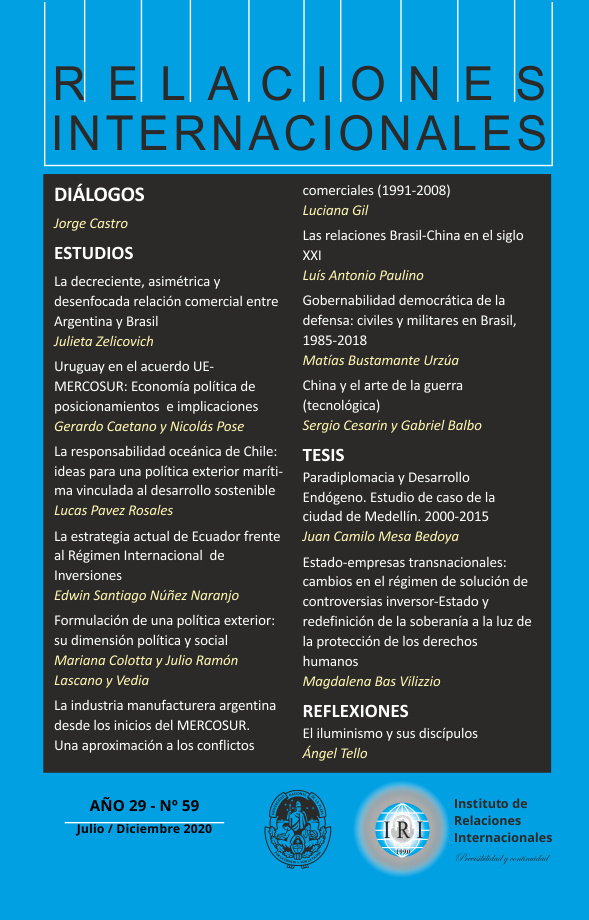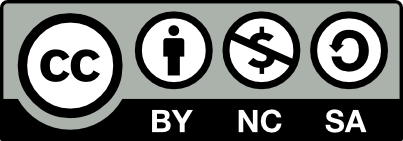China and the art of (technological) war
DOI:
https://doi.org/10.24215/23142766e110Keywords:
science, alliances, technological power, business, innovation, geopoliticsAbstract
China is on the way to become a technological power in the mid-21st Century. This process is based on four pillars: sustained increase in science and technology development budget allocations, its direct link to innovation strategies to increase productivity and upkeep exploration competitiveness, high-tech firm creation and internationalization, and national goals aimed at closing the gap between domestic S&T capacities and those of the more advanced developed Asian and Western economies. Over four decades, pro-market reforms have confirmed this path, towards transformation and capacity building in cutting edge technological sectors. Strategic tensions with the United States speed up this race and confirm China´s national goals for its companies to take the lead in artificial intelligence (AI), telecommunications and 5G networks.
Downloads
References
Bregolat, E. (2014). La obsesión tecnológica de los nuevos mandarines. Revista Política Exterior, marzo/ abril, pp.24
Capri, A. (24 de abril de 2020), Export controls and the rise of US-China techno-nationalism. Technode, Recuperado el 20/09/2020 de https://technode.com/author/alexander-capri/
Deng X. (1987) Problemas fundamentales de la China de hoy, Ediciones de Lenguas extranjeras, Beijing.
Dussel Peters, E. (2014). La inversión extranjera directa de China en América Latina: 10 estudios de caso. Universidad Nacional Autónoma de México.
European Union Chamber of Commerce in China. (2017). China Manufacturing 2025: Putting Industrial Policy Ahead of Market Forces.
Gómez Pérez-Cuadrado, E. (2016). Plan Made in China 2025. ICEX
Harwit, E. (2008), China's telecommunications revolution, Oxford University Press.
Jorgensen, B. (15 de mayo de 2020) U.S. Moves to Cut Huawei’s Access to Global Chip Suppliers, EPSNews
Katz, J. (2015). La macro-y la microeconomía del crecimiento basado en los recursos naturales. Neoestructuralismo y corrientes heterodoxas en América Latina y el Caribe a inicios del siglo XXI. Santiago: CEPAL, 2015. LC/G. 2633-P/Rev. 1. p. 243-259.
Kosacoff, B., López, A., & Pedrazzoli, M. (2007). Comercio, inversión y fragmentación del mercado global:¿ está quedando atrás América Latina?. Serie Estudios y Perspectivas, 39. CEPAL.
Li, G. (Ed.). (2011). Information Science & Technology in China: A Roadmap to 2050. Science Press.
Lu, Y. (2009). Science & technology in China: a roadmap to 2050: Strategic General Report of the Chinese Academy of Sciences. Springer Science & Business Media.
Maddison, A. (2007). Chinese Economic Performance in the Long Run—Second Edition, Revised and Updated: 960–2030 AD. Paris, FR: OECD Development Centre Studies.
Moneta, C., & Cesarín, S. (2012). Tejiendo redes. Estrategias de las empresas transnacionales asiáticas en América Latina. EDUNTREF, Argentina.
Nahm, J. and Steinfeld, E.S. (2014). Scale-up nation: China’s specialization in innovative manufacturing. World Development, 54, pp.288-300.
National Sciences Foundation (2020), The State of U.S. Science and Engineering 2020. Science & Engineering Indicators recuperado el 5/09/2020 de https://ncses.nsf.gov/pubs/nsb20201/global-r-d.
Naughton, B. (1995) Growing out of the plan. Chine economic reform 1978 – 1993, Cambridge University Press.
Naughton, B. (1997) The China circle. Economy and technology in the PRC, Taiwan, and Hong Kong, The Brooking Institution.
Polhman, T. (2019), Who is leading the 5G patent race? A patent landscape analysis on declared 5G patents and 5G standards contributions, Iplytics Noviembre 2019, https://www.iplytics.com/wp-content/uploads/2019/01/Who-Leads-the-5GPatent-Race_2019.pdf
Rosales, O. (2018). Las claves del conflicto económico China-Estados Unidos. Santiago, Chile: Facultad Latinoamericana de Ciencias Sociales (FLACSO). Recuperado de: http://www. flacsochile. org/slider/las-claves-del-conflicto-economico-chinaestadosunidos.
Shaolong, Y. (2016), The Huawei Way: Lessons from an International Tech Giant on Driving Growth by Focusing on Never-Ending Innovation, McGraw Hill Professional.
Shenkar, O. (2005) El siglo de China; Grupo editorial Norma, Bogotá.
World Intellectual Property Organization WIPO (28 de septiembre de 2020), https://www.wipo.int/ipstats/en/statistics/country_profile/profile.jsp?code=CN.
Zheng, Y. (1999). The Outlook for US-China Relations Following the 1997-1998 Summits: Chinese and American Perspectives on Security, Trade, and Cultural Exchange. Chinese University Press.
Downloads
Published
How to Cite
Issue
Section
License
Aquellos autores/as que tengan publicaciones con esta revista, aceptan los términos siguientes:
- Los autores/as conservarán sus derechos de autor y garantizarán a la revista el derecho de primera publicación de su obra. A partir de noviembre del 2020 los artículos se publicarán en la revista bajo una licencia Creative Commons Atribución- NoComercial-CompartirIgual 4.0 Internacional (CC BY-NC-SA 4.0). Acorde a estos términos, el material se puede compartir (copiar y redistribuir en cualquier medio o formato) y adaptar (remezclar, transformar y crear a partir del material otra obra), siempre que a) se cite la autoría y la fuente original de su publicación (revista y URL de la obra), b) no se use para fines comerciales y c) se mantengan los mismos términos de la licencia.
Previo a esta fecha los artículos se publicaron en la revista bajo una Licencia de reconocimiento de Creative Commons (BY-SA 2.5). - Los autores/as podrán adoptar otros acuerdos de licencia no exclusiva de distribución de la versión de la obra publicada (p. ej.: depositarla en un archivo telemático institucional o publicarla en un volumen monográfico) siempre que se indique la publicación inicial en esta revista.
- Se permite y recomienda a los autores/as difundir su obra a través de Internet (p. ej.: en archivos telemáticos institucionales o en su página web) antes y durante el proceso de envío, lo cual puede producir intercambios interesantes y aumentar las citas de la obra publicada. (Véase El efecto del acceso abierto).


























